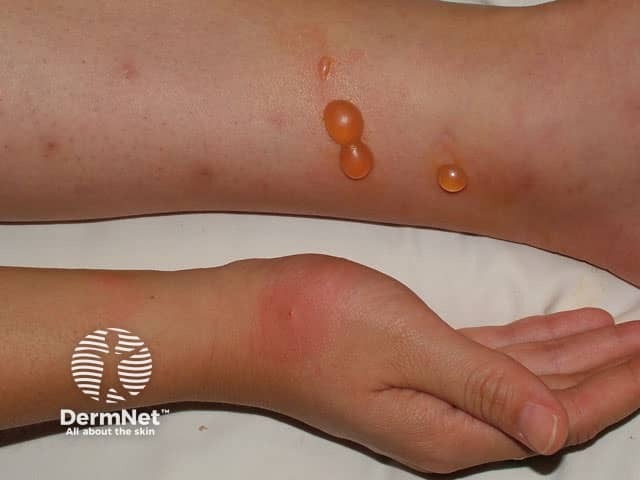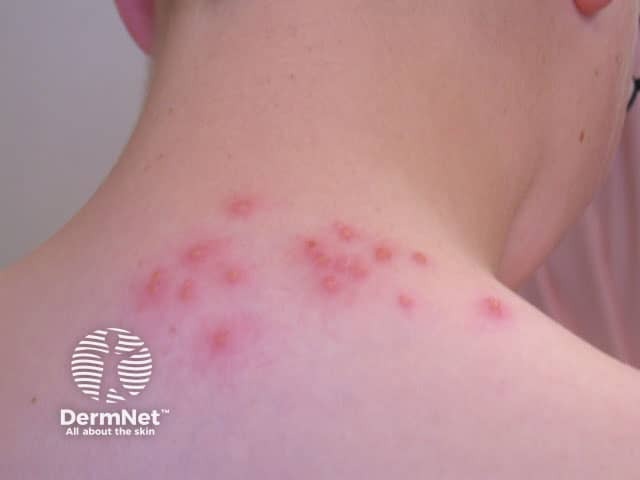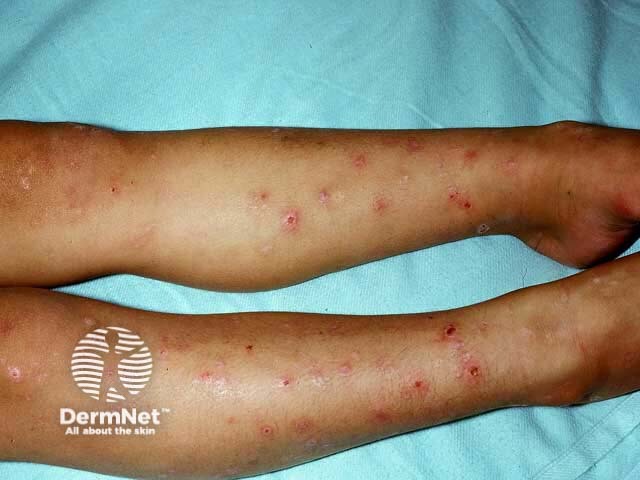Main menu
Common skin conditions

NEWS
Join DermNet PRO
Read more
Quick links
Papular urticaria — extra information
Papular urticaria
Author: Dr Amanda Oakley, Dermatologist, Hamilton, New Zealand, 1997. Update: Dr Oakley and Dr Karen Koch, Consultant Dermatologist, WITS Donald Gordon Mediclinic, Johannesburg, South Africa. March 2018. DermNet revision August 2021.
Introduction Demographics Causes Clinical features Complications Differential diagnoses Diagnosis Treatment Outcome
What is papular urticaria?
Papular urticaria is a papulovesicular reaction to insect and arachnid bites more common in children than in adults. It presents during the summer or autumn months. It is also called a persistent insect bite reaction.



Who gets papular urticaria?
Papular urticaria most often occurs in children. This is because desensitisation to insect bites has not yet developed.
It may also occur in adults, especially in travellers to new environments.
What is the cause of papular urticaria?
Papular urticaria is thought to be an immunological reaction to insect bites. The reaction settles after a few months or years, as the person becomes desensitised to the bites. The initial bite is rarely noticed.
Fleas and mites that live on cats and dogs are most often responsible.
- Fleas are easily seen with the naked eye but can be difficult to get rid of. Fleas produce many eggs, which become larvae and pupae. The average cat has only twenty fleas, but may be surrounded by 20,000 of them.
- Mites are too small to see easily but are an equally common cause of papular urticaria.
- Animals are repeatedly infested and must be treated every few weeks with a leave-on insecticide.
Not everyone with papular urticaria has pets, and it can sometimes be difficult to work out what a patient is reacting to. There have been reports of reactions to mosquitoes, bed bugs, gnats, bird mites, carpet beetles, caterpillars, and other insects.
What are the clinical features of papular urticaria?
Papular urticaria presents with clusters of itchy red bumps (papules) without systemic symptoms.
- Most often on legs and other uncovered areas such as forearms and face
- Sometimes scattered in small groups all over the body
- Appear every few days during the summer or autumn months
- Range from 0.2–2 cm in diameter
- Each papule has a central punctum
- May present as crops of fluid-filled blisters
- New lesions develop just as old ones start to clear
- A new bite may provoke reactivation of old ones
The spots remain for days to weeks and can leave postinflammatory pigmentation or hypopigmented scars, especially if they have been scratched deeply.
Papular urticaria on the legs

What are the complications of papular urticaria?
- Secondary bacterial infection following scratching causes painful pustules and scabs (impetiginisation)
- Infected insect bites can lead to cellulitis and, rarely, bacteraemia (sepsis)
- Localised cutaneous vasculitis
What is the differential diagnosis of papular urticaria?
- Scabies
- Atopic dermatitis
- Other forms of prurigo such as prurigo simplex
How is papular urticaria diagnosed?
Papular urticaria is usually a clinical diagnosis. A biopsy may support the diagnosis, as insect bites have a characteristic microscopic appearance.
The histopathology of papular urticaria includes mild dermal oedema, extravasation of erythrocytes, interstitial eosinophils, and exocytosis of lymphocytes. Vasculitic features may be noted.
What is the treatment for papular urticaria?
Preventative measures
- Wear protective clothing
- Insect repellents can be applied to exposed skin to prevent insect bites when outdoors
- Insecticides can rid the house, workplace, or school, of insects. Obtain professional help from a pest control company if necessary.
- Seek veterinary advice regarding infested animal(s)
- Keep pets outside
- Use a pyrethroid kennel and carpet spray followed by vacuuming
- Apply long-lasting insect growth regulator to the neck of cats and dogs
Symptomatic measures
- Topical steroid cream – this should be applied as soon as the itchy spots appear
- Antihistamine tablets – may reduce the size and severity of the spots and reduce itching
- Antiseptic cream can reduce or avoid secondary infection
What is the outcome of papular urticaria?
Papular urticaria is normally self-limiting. The immunological basis of this reaction means that it may take months or even years for children to become desensitised to the offending insect. Papular urticaria may clear up on holiday or after moving house.
Occasionally the eruption can clear for years and then recur unexpectedly.
References
- Cuéllar A, Rodríguez A, Halpert E, et al. Specific pattern of flea antigen recognition by IgG subclass and IgE during the progression of papular urticaria caused by flea bite. Allergol Immunopathol (Madr). 2010;38(4):197–202. doi:10.1016/j.aller.2009.09.012 Journal
- Demain JG. Papular urticaria and things that bite in the night. Curr Allergy Asthma Rep. 2003;3(4):291–303. PubMed.
- Hernandez RG, Cohen BA. Insect bite-induced hypersensitivity and the SCRATCH principles: a new approach to papular urticaria. Pediatrics. 2006;118(1):e189–96. PubMed.
- Kamath S, Kenner-Bell B. Infestations, bites, and insect repellents. Pediatr Ann. 2020;49(3):e124-31. doi:10.3928/19382359-20200214-01 PubMed
- Singh S, Mann BK. Insect bite reactions. Indian J Dermatol Venereol Leprol. 2013;79(2):151-64. doi:10.4103/0378-6323.107629 Journal
- Steen CJ, Carbonaro PA, Schwartz RA. Arthropods in dermatology. J Am Acad Dermatol. 2004;50(6):819–42, quiz 42-4. PubMed.
- Stibich AS, Schwartz RA. Papular urticaria. Cutis. 2001;68(2):89–91. PubMed.
On DermNet
- Allergies explained
- Insect bites and stings
- Urticaria – an overview
- Flea bite
- Bird mite infestation
- Scabies
- Prurigo
Other websites
- Insect bites — Medscape Drugs & Diseases
- Papular urticaria — Medscape Drugs & Diseases
